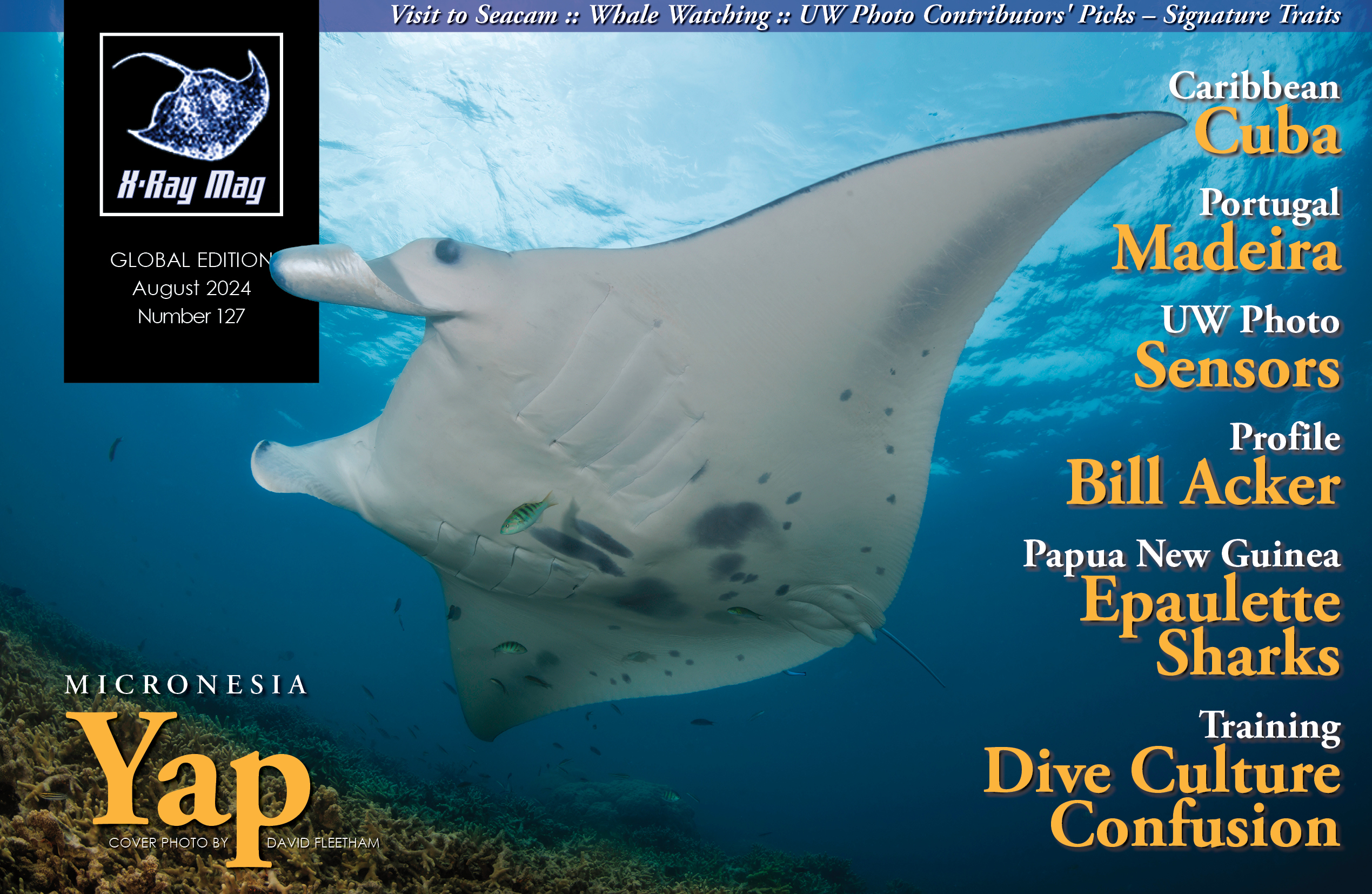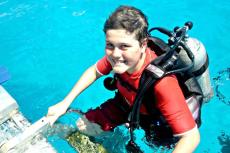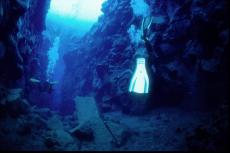The island of Yap, a tiny dot in the vast Pacific Ocean, is home to a world-renowned divе resort, embedded in the authentic culture and traditions of the Yapese people. It all happened because of one person whose charisma, enthusiasm and desire to share the thrill of diving became the driving force behind the development of diving in Yap. That person is Bill Acker, founder and owner of Manta Ray Bay Resort & Yap Divers. Svetlana Murashkina tells his story.
Contributed by
Bill Acker is a member of the original class of SSI Platinum Pro Divers. As a PADI and SSI Instructor, he remains active in exploring new dive sites and teaching the sport to those interested in sharing his love of the marine environment. His accomplishments are recognized by the worldwide diving community. In 2014, Acker was inducted into the Scuba Diving Hall of Fame for pioneering diving in Yap. He celebrated 30 years in business that same year. In addition, his dive resort was recently recognized in 2024 as the best dive resort in the Pacific and Indian Ocean.
Manta Ray Bay Resort & Yap Divers are known for having many repeat guests, myself included. Not only is it a great place with awesome diving and professional staff, but the friendly atmosphere created by Acker and his whole family at the resort instills a real family feel.

Childhood dream comes true
Acker has dreamed of faraway tropical islands ever since his childhood. Growing up in Garland, Texas, USA, he read and watched everything he could find about Southeast Asia, including books by Rudyard Kipling and Joseph Conrad. He was drawn to mysterious lands overseas without knowing why. Of his dream destination and place to live, he said: “If coconut trees do not grow here, I cannot live either. I need warmth. And palm trees live only in an eight-degree strip along the equator, inhabiting the most wonderful places on earth!”
First time in Yap
Bill first visited the island of Yap in 1976 as a Peace Corps volunteer. At that time, he had graduated from high school in Garland and attended the University of Texas, where he earned a degree in marketing. He then worked in the city center of Dallas in the men’s clothing industry (not the most exciting job in the world, he said with a grin).
One day, he read in a newspaper that the US government was sending volunteers to work in various “undeveloped” countries. Two positions were open: Yap and Tonga. In Tonga, the work involved setting up a cooperative fishing enterprise, and in Yap, it involved drawing up a five-year economic development plan. As a young man, he thought that it would be better for his future career to work in Yap, so he agreed to a two-year contract.
Island life
He really loved the island, the climate, and the people. The only thing that bothered him was that it was so far away from everything, isolated from the rest of the world...
After two years in the Peace Corps, Acker attended the University of Hawaii’s Graduate School of Business and planned to settle there. But an invitation from friends in Yap changed his plans and his whole life. He left Honolulu and became the manager of the WAAB Transportation Company, where he worked for the next 13 years.
One of the activities of the company was the production of oxygen. Some people who were going to fly to Palau to dive asked if they could fill their tanks there. This sparked his interest in scuba diving. At that time, there was no diving on Yap—no dive centers, no decent hotels.
WAAB Transportation then invited a dive instructor to visit, and together, all 45 of their employees started learning how to dive. The idea was simple and appealing: everyone could go spearfishing, catch fish, barbecue them up and party all together! And this is how the dive industry in Yap started. In 1985, the idea of opening a dive center was born, and the search for new dive sites began. So, Acker started a dive business—almost by accident. A happy accident indeed for divers all over the world.

Yap Divers
By the summer of 1986, the dive center was ready to open. It was affiliated with both NAUI and PADI. However, during its construction, there was no specific knowledge of how to build a dive centre. The idea of how it would work came from the notion that guests would come with equipment, so the center would have to store it somewhere, somehow. Acker’s personal requirements for the accommodations were basic: It has to be clean, with a good shower, a soft towel and a comfortable bed. That would do. Acker was responsible for the construction of the buildings. He also came up with the idea of giving each room a different name. As for the design, a good friend from Palau offered a lot of advice.
The expectations and goals of the creators of Yap Divers were no less than to create the best dedicated dive resort in the world. Of course, there were unique obstacles. Everything about living on a very remote, isolated tropical island added to the difficulties. Supplies take months to get, if you can even get them at all, and the cost of visiting Yap in terms of the airline fares has made sustaining the business a challenge. But the result has been magnificent, and Acker is proud of what they have created and continue to do today.

Manta rays
Another happy accident occurred with the manta rays. The locals told stories about manta rays and their frequent haunts in the channels. Acker’s house was situated very close to the channels. So, Acker started diving with these beautiful creatures. With no diving experience outside of Yap, and only reading about the rest of the world’s oceans in dive magazines, he was sure that manta rays were everywhere, so he thought that no one would be interested in coming to Yap to see manta rays.
At that time, 35 years ago, images of mantas could be seen everywhere—in advertisements, in dive center logos, and in photos (but people were afraid of sharks. Their attitude towards sharks was very different back then). Manta rays became the most popular creature, so Bill had the impression that manta rays were very common. An ordinary phenomenon. So, when he took people on dives, manta rays were the last thing he wanted to show them, let alone dive with.
Enter Paul Tzimoulis, editor-in-chief of Skin Diver magazine, the leading dive magazine in the United States at the time. Yap Divers hosted him in their first attempt at advertising. Paul and his wife, Geri, spent a few days on Yap, staying at Acker’s house, but there was a heavy storm, and they did not dive. On the last evening before leaving the island, the editor’s wife had managed to break her collarbone, and the fracture was serious. A cast could not be put on the fracture, and it was recommended that they not fly for seven days. So, they had to stay put for a whole week.
The next day, everything was terrible. Geri felt bad. Everyone’s spirits were down. And the only Yap Divers boat was moored in the channel right in front of the house. So, Acker suggested a dive with the manta rays. The answer was immediate: “That’s impossible.” But Acker decided that it was “impossible” to leave Geri on shore in that miserable situation. He continued to try to persuade the couple to go, saying: “It’s very close. Let’s look at the mantas and come back. It will only take us an hour.” Paul asked again: “So, are you saying that we can go diving and we will definitely see mantas?”
Indeed, they went to the nearest dive site. From Acker’s point of view, if there had been anything else more interesting to show them, he would never, ever have mentioned the manta rays. But they dived, and they saw what every diver who visits Yap today sees: manta rays, lots of them, coming to be cleaned and basking in the divers’ bubbles.
After the dive, Paul said: “No one anywhere in the world can say for sure that during a dive, we will see mantas!” Thus, Yap, with its magnificent manta rays, was featured on the covers of dive magazine issues under the guidance of the late Paul Tzimoulis, Hall of Fame dive pioneer and publisher. Yap Divers enjoyed the glory of being the only place in the world to experience this unique manta dive!

Manta ray awareness
In 2003, Yap Divers introduced the PADI Manta Ray Awareness specialty course. It includes a one-hour lecture and two dives with manta rays. It covers how to tell females from males, how they behave, and when and why they come to the channels. Acker shared his extensive knowledge of Yap’s manta rays. He has made over 18,400 dives, mostly in Yap, and most of them with manta rays. Probably, no one else in the world has made as many manta ray dives as he has.
Acker is still active in teaching the Manta Ray Awareness specialty course, and the center is training Acker’s son-in-law, Francis, to be a dive instructor so he, too, can teach the course. The guides at Yap Divers are also very knowledgeable about Yap’s manta rays, and they are a wealth of information for the resort’s guests.
A big family and family business
While in Yap, Acker met and married a local woman, Patricia Mangthin. According to Yapese tradition, he had to give shell money as a dowry for his wife. Of course, as an American, he could not have shell money! But it was given to him by the family he was living with at the time.
Bill and Patricia live together with great respect and devotion for one another. They have four children (Numie, Nathan, Valerie, and Opie) and six grandchildren.
All members of the family are active in the sport of diving and share Acker’s commitment to the safety and preservation of Yap’s natural resources. Patricia and all four of the children have been active in the construction and operation of Manta Ray Bay Resort.
Patricia started the Taro Leaf Spa, and her treatments are based in part on traditional knowledge passed down from her grandfather. She also spent three months training in spa treatments in Cebu, Philippines. She also started the Planet Blue Kayak Tour division. She still occasionally kayaks with guests.
Bill and Patricia’s eldest daughter, Jessica “Numie” Acker, has worked at the hotel since she was 12 years old and is now the general manager.

Yapese culture and tourism
Yap is known for its unique stone money. But before Acker’s ventures, there was no tourism on Yap. When divers began to visit the island, it was Acker’s team that started to hike to the Yapese villages hidden in the depths of the island. They brought guests with them, and the locals spoke to them, showing them their crafts and dancing, and treating them to local fruits. They even let visitors chew betel nut right off the tree. Most of the proceeds from the village cultural tours that Manta Ray Bay Resort offers its guests go back to the community.
“Retirement”
From Acker’s point of view, the word “retirement,” as it is traditionally used, does not have the same meaning for him. Manta Ray Bay Resort & Yap Divers was conceived, built, developed and run by him, and he has been very fortunate to have a strong, supportive family working with him, as well as a great staff. He still loves everything about the business that got him into it in the first place—namely, meeting people, trying to fulfill their dreams, and, of course, the diving.
Acker doubts that he will ever fully “retire,” but he, along with his wife, are officially retired, splitting their time between Yap and the Philippines and spending less and less time in Yap these days. The goal is to spend half the year in Yap and half the year traveling. They both still dive, Acker much more often than Patricia, but she still dives as well. They dive in Yap, and he dives almost every day when he is home because he wants to be with the guests as much as possible.
They also dive in the Philippines when they are there. Now that Numie Acker is the general manager, father and daughter talk together daily, of course, about the business, and Bill helps as much as he can. He is particularly active in the dive shop, marketing and recruiting prospective new employees.
When asked if he had to do it all over again, where would he choose to live and what would he do, Bill is unequivocal: “Yap Island, the municipality of Ma’ap, and the village of Digin. In other words, I wouldn’t change a thing. The Yapese people are the most humble and friendliest people I have ever met. The Yapese are smart, industrious and proud of their island and culture. I have a beautiful wife. I live in a good place where the diving is great. They say if you do a job you love, you will never really work a day in your life. I am living the dream and very grateful for it.”
Making a comeback
Like many dive centers and resorts, Manta Ray Bay Resort & Yap Divers endured the difficult times of lockdown during the Covid-19 pandemic. They struggled mightily but are still here. Getting their customers back has been a slow process, and many of their co-workers were forced to leave the island during Covid and have not returned. Staffing is a challenge, but the reefs are healthy, the marine life is as prolific as it was before Covid, and the climate provides a perfect tropical paradise. ■
For more information, please visit: mantaray.com






























